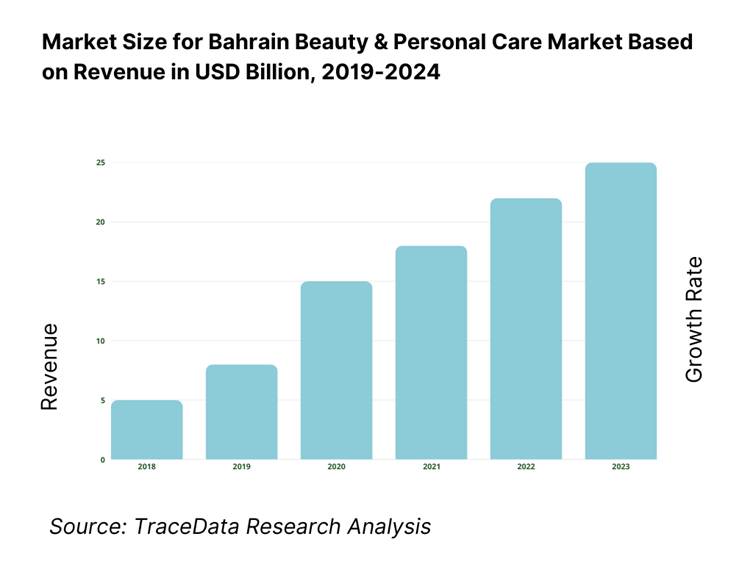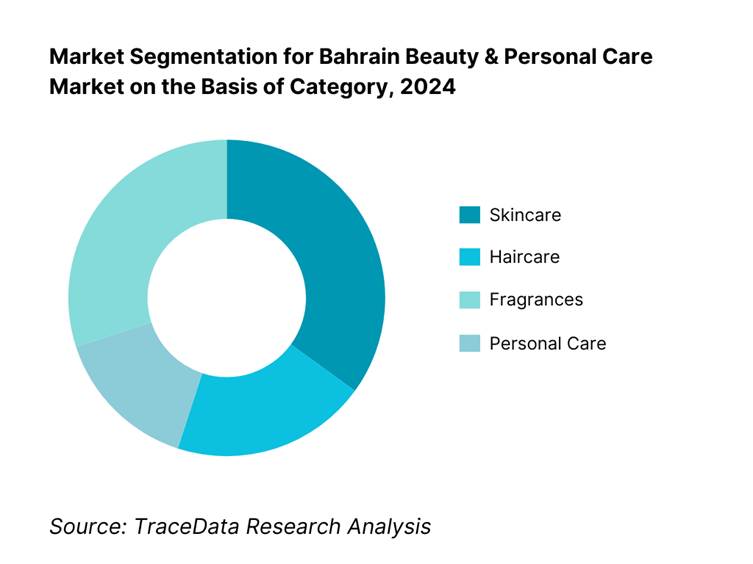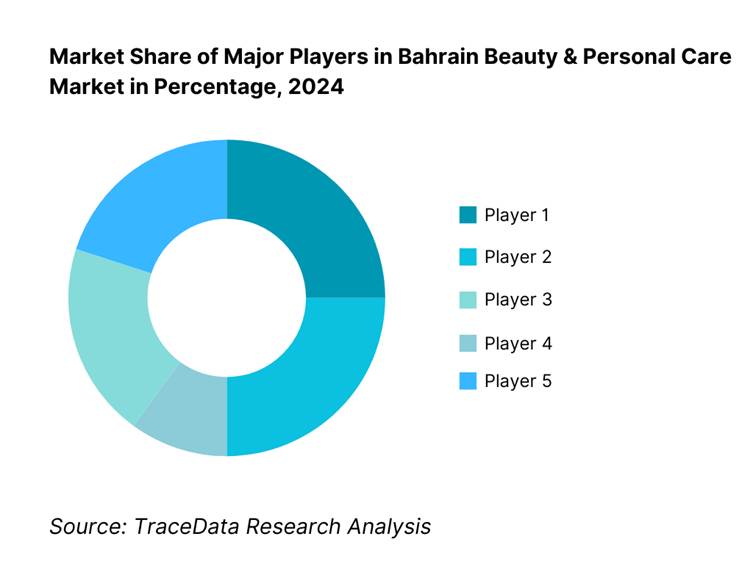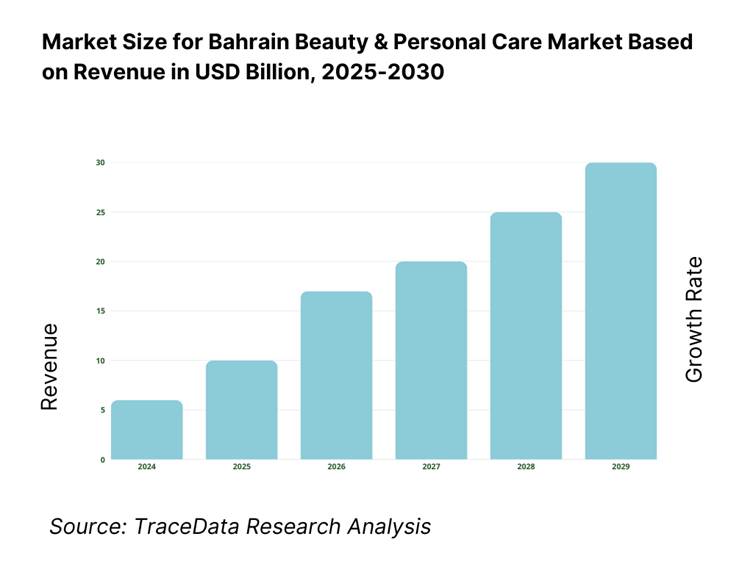Bahrain Beauty & Personal Care Market Outlook to 2030
By Product Category, By Price Tier, By Distribution Channel, By Consumer Cohort, By Positioning/Claims, and By Governorate
- Product Code: TDR0231
- Region: Middle East
- Published on: August 2025
- Total Pages: 110
Introducing the World's FirstPay-Per-Section Market Reports
Why pay for the full report when you need just a part?
Start Building Your Report
Scroll down to see available sections
Report Summary
The report titled “Bahrain Beauty & Personal Care Market Outlook to 2030 – By Product Category, By Price Tier, By Distribution Channel, By Consumer Cohort, By Positioning/Claims, and By Governorate” provides a comprehensive analysis of the beauty and personal care industry in Bahrain. The report covers the overview and genesis of the sector; overall market size in revenue terms; and detailed segmentation. It examines trends and developments, the regulatory landscape, customer-level profiling, issues and challenges, and the competitive landscape including competition scenario, cross-comparison, opportunities and bottlenecks, and company profiling of major players. The report concludes with future market projections based on product categories, channels, consumer cohorts, claims/positioning, and governorates—linking cause-and-effect relationships (tourism inflow, disposable-income cohorts, mall footfall, e-commerce adoption, regulatory alignment) and success case studies (omnichannel activation, pharmacy-dermo tie-ups, heritage fragrance collaborations, refill/reuse initiatives) to highlight the principal opportunities and cautions for stakeholders.
Bahrain Beauty & Personal Care Market Overview and Size
The beauty & personal care market in Bahrain is valued at USD 229.8 million in 2023, according to recent consumer market data. This market size is underpinned by a rising young demographic, increasing digital penetration, and growing grooming awareness, with the personal care segment alone contributing USD 104.2 million, reflecting solid consumer demand and economic resilience.
Key regional hubs such as Manama and Muharraq dominate Bahrain’s beauty & personal care landscape due to their concentration of retail infrastructure, luxury mall networks, and affluent expatriate communities. These urban centers benefit from high footfall, strong brand representation, and the presence of international and niche beauty outlets, together reinforcing their leadership in market activity.

What Factors are Leading to the Growth of the Bahrain Beauty & Personal Care Market:
Tourism inflow & retail tourism: Inbound demand is a structural tailwind for Bahrain’s beauty and personal care (BPC) sell-through. The kingdom received 14,900,000 visitors with 19,200,000 tourist nights and BD 1,900,000,000 in inbound tourism receipts, with average daily spend at BD 69.1 per visitor—directly benefiting duty-free, malls and perfumery. Air connectivity supports retail tourism: Bahrain International Airport processed 9,400,000 passengers and the terminal is designed for 14,000,000 annual passengers, sustaining steady beauty footfall for arrivals and departures. Together these flows anchor premium fragrance and skincare launches, gifting and travel-retail exclusives across Manama’s flagship malls and airport outlets.
High disposable-income cohorts: Affordability for prestige beauty is underpinned by macro incomes and a compact, highly urbanized consumer base. World Bank data show Bahrain’s GDP per capita at US$ 30,048.2, while population stood at 1,588,670, concentrating purchasing power in Manama and Muharraq. Household final consumption expenditure reached US$ 17,953,780,479, signaling strong private outlays relevant to premium categories (fragrance, dermocosmetics). Labor market data add depth: LMRA issued 33,740 new private-sector work permits in Q2, expanding the expatriate professional cohort that over-indexes on salon services and international brands. These numeric anchors explain sustained spend on luxury fragrance, devices and clinic-adjacent skincare.
Mall-led retail ecosystem: Bahrain’s beauty retailing is concentrated in a modern mall circuit that couples entertainment with high-end brand presentation. City Centre Bahrain alone reports 14,600,000 annual visitors, providing reliable traffic for anchor beauty chains and mono-brand boutiques. The Avenues – Bahrain offers 75,000 m² (Phase I GLA) of waterfront retail, a setting used for prestige pop-ups and experiential launches that favor fragrance and color cosmetics. Airport retail extends the circuit, with a terminal engineered for 14,000,000 passengers and a current flow of 9,400,000, reinforcing beauty’s high-impulse channels (duty-free and last-mile gifting). This mall-airport pairing shapes merchandising, staffing and inventory strategies for global BPC houses.
Which Industry Challenges Have Impacted the Growth of the Bahrain Beauty & Personal Care Market:
Small market scale vs. listing intensity: Beauty brand expansion faces a finite domestic base: population totals 1,588,670, concentrating demand into a handful of destination malls and specialty doors. Private-sector establishment data indicate roughly 19,000 operating units, implying a long tail of small firms rather than deep national chains, while SMEs account for about 93 out of every 100 commercial establishments—pressuring brands to justify premium shelf fees with limited unit velocity. These structural numbers translate into cautious SKU curation, selective roll-outs and shorter promotional calendars to protect ROI on fixtures and field teams.
Import lead-times & MOQ constraints: Bahrain is an import-dependent BPC market, reflected in HS-33 inflows of US$ 182,570,000. While connectivity is strong—airport cargo handled 244,420 tonnes and the main seaport is specified at 1,000,000 TEU initial capacity—regional shipping cycles and supplier minimum order quantities (MOQs) can stretch replenishment for niche lines and seasonal sets. In logistics benchmarking, Bahrain ranked 34 globally in the World Bank’s 2023 Logistics Performance Index; brands still plan buffer inventory for launches tied to Eid and tourist peaks. These concrete volumes and rankings explain cautious assortment breadth and staggered allocations for prestige exclusives.
Fragmented salon channel: Downstream services that drive haircare, nail, and dermacosmetic sell-out are distributed across many small providers. LMRA’s survey shows private-sector new work permits at 33,740 in a single quarter, aligning with a dense base of micro-employers in personal services. Overall private-sector activity is spread across approximately 19,000 establishments, while the regulated clinical-aesthetics interface counts 877 licensed private healthcare facilities within 924 total licensed facilities—indicative of numerous points of care relevant to cosmeceutical referrals. This multiplicity raises training, brand standardization and channel compliance costs for salon-exclusive and clinic-dispensed brands.
What are the Regulations and Initiatives which have Governed the Market:
GSO 1943 Safety (cosmetics & personal care): Bahrain applies the Gulf Technical Regulation GSO 1943:2024 for cosmetic product safety—adopted through the national standards portal. As a GCC member (6 states), Bahrain aligns on core requirements that cover safety parameters plus labeling and packaging, including Arabic labeling. For global beauty portfolios, this harmonization cuts duplication across the peninsula but requires centralized regulatory files and local label compliance at the SKU level. Links: Bahrain Standards & Metrology Directorate listing for GSO 1943:2024; GCC Standardization Organization overview noting membership of 6 governments.
GSO 2528 Claims (allowed cosmetic claims): Marketing language is governed by GSO 2528:2024, which sets criteria for acceptable cosmetic and personal care claims and de-scopes products with non-cosmetic therapeutic positioning. Bahrain’s standards store lists the regulation, and the public consultation text provides the operative definitions and annexes used by market inspectors. For brand teams, substantiation dossiers and translation controls must match the 2528 criteria to avoid relabeling or withdrawal. Links: Bahrain Standards & Metrology Directorate entry for GSO 2528:2024; official bilingual text circulated via Saudi NCC portal.
ISO 22716 GMP (manufacturing practice): Manufacturers and importers are expected to align with ISO 22716 guidance covering production, control, storage and shipment; the standard is referenced in international guidance used by authorities. Compliance evidence (e.g., audit certificates, SOPs) facilitates product registration and post-market oversight in Bahrain under regional safety rules. Links: ISO’s official abstract for ISO 22716 (cosmetics GMP) and the U.S. FDA’s updated guidance confirming consideration of ISO 22716 within harmonized GMP practice—both widely cited by regulators in dossiers.
Bahrain Beauty & Personal Care Market Segmentation
By Category: Bahrain’s beauty & personal care market is segmented into skincare, haircare, fragrances, and personal care. The skincare sub-segment leads in market share at approximately 35 percent, driven by high consumer interest in premium moisturizers, serums, and sun care. International brands like L’Oréal and Estée Lauder leverage superior formulations and strong in-store experiences, fostering trust among Bahraini consumers for skincare routines infused with scientific or luxury positioning.

By Sales Channel: The market is divided across specialty & pharmacy retail, hypermarkets/supermarkets, and online channels. The offline specialty & pharmacy segment holds the largest share at 50 percent, thanks to personalized service, brand counters, and dermatologist-facilitated product discovery. Multi-brand beauty chains and pharmacies remain trusted venues for experiential beauty purchases in Bahrain. Hypermarkets account for 26 percent, where value and convenience drive volume. Notably, online channels have already captured 24 percent of market share, propelled by growing e-commerce adoption and social media influence.

Competitive Landscape in Bahrain Beauty & Personal Care Market
The Bahrain beauty & personal care market is relatively concentrated, with multinational groups (L’Oréal, Estée Lauder, Unilever, P&G, Beiersdorf, Coty, Shiseido) and regional fragrance houses (Ajmal, Arabian Oud, Rasasi, Junaid Perfumes) shaping shelf space and launch calendars. However, the rise of omnichannel retail and digital-first entrants—spanning specialty chains (Sephora, Faces), pharmacy-led dermocosmetics, and e-commerce/social commerce via noon and cross-border Amazon.ae—has diversified consumer choice with niche, clean/halal, and artisanal oud offerings, expanding access to personalized routines, gifting sets, and rapid new-product cycles.
Name | Founding Year | Original Headquarters |
L’Oréal | 1909 | Clichy, France |
Procter & Gamble (P&G) | 1837 | Cincinnati, USA |
Unilever | 1929 | London, UK |
Estée Lauder Companies | 1946 | New York, USA |
Beiersdorf (NIVEA) | 1882 | Hamburg, Germany |
Coty Inc. | 1904 | Paris, France |
Shiseido | 1872 | Tokyo, Japan |
Ajmal Perfumes (Regional) | 1951 | Dubai, UAE |
Arabian Oud (Regional) | 1982 | Riyadh, Saudi Arabia |
Junaid Perfumes | 1910 | Manama, Bahrain |
Some of the Recent Competitor Trends and Key Information About Competitors Include:
L’Oréal: As one of the largest international beauty groups operating in Bahrain, L’Oréal expanded its dermo-cosmetic and skincare portfolio in 2024 through pharmacies and specialty retailers. The company emphasized sustainable packaging and refill stations in GCC malls, aligning with consumer demand for eco-friendly beauty.
Estée Lauder Companies: With a strong prestige positioning, Estée Lauder reinforced its luxury fragrance and skincare lines in Bahrain by launching exclusive mall-based experiential counters. The company’s strategy has been to target affluent consumers and inbound tourists with personalized beauty consultations and premium gifting sets.
Procter & Gamble (P&G): P&G maintained dominance in the mass personal care and haircare categories, with significant distribution in hypermarkets such as Carrefour and Lulu. In 2024, the company increased its digital marketing investments, using influencers and local content creators to reach younger Bahraini consumers.
Ajmal Perfumes: A regional fragrance powerhouse, Ajmal launched new oud and oriental blends tailored to Bahraini cultural preferences. The brand leveraged seasonal campaigns during Ramadan and Eid, driving strong footfall at local perfume boutiques. Its heritage positioning continues to resonate with national consumers seeking authentic regional scents.
Junaid Perfumes: As one of Bahrain’s oldest and most iconic perfume houses, Junaid focused on expanding its niche fragrance collections while strengthening its flagship presence in Manama. In 2024, the brand introduced limited-edition lines inspired by Bahraini heritage, appealing to both locals and GCC tourists.

What Lies Ahead for Bahrain Beauty & Personal Care Market?
The Bahrain beauty & personal care market is anticipated to maintain steady momentum through the end of the decade, supported by strong consumer spending, the resilience of retail tourism, and regulatory alignment with Gulf standards. Growth will be driven by rising demand for premium skincare, fragrances rooted in regional heritage, and the increasing role of digital commerce in shaping consumer choices.
Rise of Omnichannel Retail Models: The future of beauty retail in Bahrain is likely to evolve toward omnichannel models, where physical mall counters and boutiques integrate seamlessly with e-commerce and social commerce platforms. With over 9.4 million airport passengers annually and 14.6 million mall visitors to City Centre Bahrain, brands will increasingly leverage both offline and digital touchpoints to capture tourists and local consumers alike.
Focus on Clean and Halal Beauty: As global consumers demand cleaner formulations, Bahrain is set to emphasize halal and eco-conscious beauty products. The Gulf Technical Regulation GSO 1943 ensures product safety and GSO 2528 regulates claims, providing a structured compliance environment that encourages innovation in halal-certified skincare, fragrances, and personal care items. This will align with rising consumer expectations for ethical and culturally relevant beauty.
Expansion of Niche and Prestige Fragrances: Fragrance will continue to anchor Bahrain’s BPC market, with increasing consumer preference for niche oud, amber, and artisanal blends. Regional heritage players like Ajmal, Arabian Oud, and Junaid Perfumes are expected to expand offerings tailored to Bahraini and GCC tastes, while global giants like Estée Lauder and Coty strengthen prestige launches. The convergence of cultural affinity and gifting traditions will sustain fragrance’s dominance.
Leveraging AI and Personalization in Beauty Retail: Digital transformation in Bahrain’s beauty market will extend beyond e-commerce to include AI-driven personalization. Retailers and brands are expected to deploy AI-enabled beauty apps for skin analysis, shade-matching, and personalized product recommendations. Coupled with data analytics on consumer spending (household final consumption: US$ 17.95 billion), personalization will enhance customer experience, drive repeat purchases, and improve ROI for international and regional players.

Bahrain Beauty & Personal Care Market Segmentation
By Product Category
Skincare
Haircare
Fragrances
Color Cosmetics
Bath & Shower
Men’s Grooming
Oral Care
By Price Tier
Mass Market
Masstige
Premium
Prestige & Niche
By Distribution Channel
Beauty Specialty Stores
Pharmacies/Parapharmacies
Department Stores
Hypermarkets/Supermarkets
E-commerce & Social Commerce
Salon/Professional Outlets
Duty-Free & Airport Retail
By Consumer Cohort
Bahraini Nationals
Arab Expatriates
South Asian Expatriates
Western Expatriates
Tourists
Generational Segments
By Positioning/Claims\
Halal-certified Beauty
Clean/Natural/Organic Products
Dermatologist-recommended (clinical skincare, dermocosmetics)
Alcohol-free & Sensitive-skin Care
Anti-aging / Barrier Repair
SPF & Sun-protection
Sustainable/Refillable Packaging
Players Mentioned in the Report:
L’Oréal Middle East
Procter & Gamble Gulf
Estée Lauder Companies Middle East
Unilever Gulf
Beiersdorf Middle East (NIVEA)
Coty Middle East
Shiseido Middle East
Kenvue (J&J) Middle East
Henkel Beauty Care MEA
Reckitt Personal Care
LVMH Perfumes & Cosmetics ME
Ajmal Perfumes (regional)
Junaid Perfumes (local)
Arabian Oud (regional)
Rasasi Perfumes (regional)
Key Target Audience
Retail Investors & Venture Capitalist Firms
Private Equity Firms focusing on GCC Consumer Goods
Regional Retail & Franchise Managers (Beauty Specialty Chains)
Luxury Mall Real Estate Developers (e.g., Seef Mall, City Centre Bahrain)
Leading Beauty Brand Distributors & Importers in Bahrain & GCC
Bahrain Standardization & Metrology Directorate (BSMD)
Ministry of Industry & Commerce, Bahrain
Bahrain Tourism and Exhibitions Authority
Time Period:
Historical Period: 2019-2024
Base Year: 2025
- Forecast Period: 2025-2030
Report Coverage
Choose individual sections to purchase. Mix and match as you like.
- -
- -
- $100
4.1. Value Chain Process-Roles of Manufacturers, Distributors, Retailers, Salons, and Consumers, along with Challenges Faced
4.2. Relationship and Engagement Models Across Channels
4.3. Supply Decision-Making Process for Imports, Assortment, and Promotions
$2505.1. Sales of Key Beauty & Personal Care Categories in Bahrain (Skincare, Haircare, Fragrances, Cosmetics, Personal Care), 2019-2024
$150- $100
- $200
8.1. Consumer Expenditure on Beauty & Personal Care, 2019-2024
8.2. Import Dependency (HS-33 Cosmetics and Personal Care), 2019-2024
$3009.1. By Product Category (Skincare, Haircare, Fragrances, Color Cosmetics, Bath & Shower, Mens Grooming, Oral Care), 2023-2024P
9.2. By Price Tier (Mass, Masstige, Premium, Prestige & Niche), 2023-2024P
9.3. By Distribution Channel (Specialty Stores, Pharmacies, Hypermarkets, Online/E-Commerce, Salons, Duty-Free), 2023-2024P
9.4. By Consumer Cohort (Nationals, Arab Expats, South Asian Expats, Western Expats, Tourists), 2023-2024P
9.5. By Positioning/Claims (Halal-Certified, Clean/Natural, Dermatologist-Recommended, Alcohol-Free/Sensitive Skin, SPF/Suncare, Sustainable/Refillable), 2023-2024P
$40010.1. Customer Landscape and Cohort Analysis
10.2. Consumer Journey and Purchase Decision-Making Process
10.3. Needs, Desires, and Pain Point Analysis
10.4. Gap Analysis Framework
$50011.1. Trends and Developments in Bahrain Beauty & Personal Care Market
11.2. Growth Drivers for Bahrain Beauty & Personal Care Market
11.3. SWOT Analysis for Bahrain Beauty & Personal Care Market
11.4. Issues and Challenges in Bahrain Beauty & Personal Care Market
11.5. Regulatory Landscape (GSO 1943 Safety, GSO 2528 Claims, ISO 22716 GMP)
$20012.1. Market Size and Future Potential for Online Beauty & Personal Care Sales, 2019-2030
12.2. Business Models and Revenue Streams in E-Commerce and Social Commerce
12.3. Cross-Comparison of Leading E-Commerce/Omnichannel Beauty Platforms Based on Company Overview, Revenue Streams, GMV, Operating Channels, Number of Outlets/Distribution Reach, and Other Variables
$50013.1. Category Penetration Rates Across Skincare, Haircare, Fragrance, and Color Cosmetics, 2019-2030
13.2. Shifts in Category Penetration Over Time with Key Drivers
13.3. Sub-Segments with Higher Penetration (e.g., Fragrances, Dermo-Cosmetics)
$250- $250
- $250
- $150
17.1. Market Share of Key Global FMCG Players in Bahrain, 2023
17.2. Market Share of Key Prestige Beauty & Luxury Fragrance Brands, 2024
17.3. Market Share of Key Regional and Local Fragrance Houses, 2024
17.4. Benchmark of Key Competitors
17.5. Strengths and Weaknesses Mapping
17.6. Operating Model Analysis Framework
17.7. Gartner Magic Quadrant Positioning
17.8. Bowmans Strategic Clock-Competitive Advantage Assessment
$75018.1. Consumer Expenditure on Beauty & Personal Care, 2025-2030
18.2. Import Dependency and Retail Sales, 2025-2030
$30019.1. By Product Category (Skincare, Haircare, Fragrances, Color Cosmetics, Bath & Shower, Mens Grooming, Oral Care), 2025-2030
19.2. By Price Tier (Mass, Masstige, Premium, Prestige & Niche), 2025-2030
19.3. By Distribution Channel (Specialty Stores, Pharmacies, Hypermarkets, Online/E-Commerce, Salons, Duty-Free), 2025-2030
19.4. By Consumer Cohort (Nationals, Arab Expats, South Asian Expats, Western Expats, Tourists), 2025-2030
19.5. By Positioning/Claims (Halal-Certified, Clean/Natural, Dermatologist-Recommended, Alcohol-Free/Sensitive Skin, SPF/Suncare, Sustainable/Refillable), 2025-2030
$400- $250
- $250
Research Methodology
Step 1: Ecosystem Creation
We begin by mapping the complete ecosystem of the Bahrain Beauty & Personal Care market, identifying both demand-side and supply-side entities. On the demand side, this includes Bahraini nationals, expatriate residents, and inbound tourists—together totaling 14.9 million annual visitors and 1.59 million residents. On the supply side, we map distributors, specialty retailers (Sephora, Faces), pharmacies (Boots, Nasser Pharmacy), hypermarkets (Carrefour, Lulu), online platforms, and salon/spa networks. Based on this mapping, we shortlist 5–6 leading players such as L’Oréal, Estée Lauder, Procter & Gamble, Ajmal, Junaid, and Unilever, evaluating them by brand portfolio strength, retail presence, and financial disclosures.
Step 2: Desk Research
We then conduct exhaustive desk research using government statistics, trade data, and proprietary industry databases to develop a foundational understanding of the Bahrain BPC market. This includes referencing HS-33 cosmetic import flows valued at US$ 182.5 million, airport passenger volumes of 9.4 million, and mall visitation data such as 14.6 million visitors at City Centre Bahrain. Company-level analysis draws upon press releases, annual reports, distributor announcements, and retail chain insights. This desk-based stage enables detailed benchmarking of revenues, portfolio breadth, distribution channels, and category splits across skincare, fragrances, haircare, and personal care.
Step 3: Primary Research
We carry out structured interviews with C-level executives, country managers, and distributors of BPC companies operating in Bahrain. End-user inputs are gathered from beauty specialty retailers, pharmacists, and salon/spa managers to understand sell-through dynamics. These interactions validate hypotheses developed from desk research, while revealing ground-level operational metrics such as in-store conversion, minimum order quantity constraints, and channel margins. As part of the validation strategy, we also engage in disguised client inquiries with leading brands and distributors. This allows us to cross-check financials, assortment decisions, and promotional structures against secondary data for consistency and accuracy.
Step 4: Sanity Check
To finalize the market sizing and segmentation, we conduct a top-down and bottom-up triangulation exercise. On the top-down side, Bahrain’s household consumption expenditure of US$ 17.95 billion and GDP per capita of US$ 30,048 are benchmarked to assess beauty expenditure intensity. On the bottom-up side, we aggregate channel-level data from mall traffic, duty-free passenger volumes, and import flows to arrive at a coherent market figure. Both perspectives are reconciled to ensure logical consistency and remove outliers, providing a sanity-checked and validated market model that reflects real-world operating conditions in Bahrain.
FAQs
01 What is the potential for the Bahrain Beauty & Personal Care Market?
The Bahrain Beauty & Personal Care Market is poised for steady growth, reaching a valuation of USD 229.8 million in 2023 according to consumer market data. This potential is anchored in rising household consumption expenditure of US$ 17.95 billion, a GDP per capita of US$ 30,048, and a strong inflow of 14.9 million visitors annually. The market’s potential is further strengthened by consumer preference for premium fragrances, growing skincare adoption, and expanding omnichannel retail presence in Bahrain’s luxury malls and duty-free outlets.
02 Who are the Key Players in the Bahrain Beauty & Personal Care Market?
The Bahrain Beauty & Personal Care Market features both multinational and regional players. Key global companies include L’Oréal, Procter & Gamble, Unilever, Estée Lauder, Beiersdorf, Coty, and Shiseido. Regional fragrance leaders such as Ajmal Perfumes, Arabian Oud, and Rasasi play a dominant cultural role. Bahrain’s own heritage brand, Junaid Perfumes, maintains strong domestic relevance. These players dominate the market due to their established distribution networks, strong mall presence, and brand loyalty among both locals and expatriates.
03 What are the Growth Drivers for the Bahrain Beauty & Personal Care Market?
The primary growth drivers include tourism inflows—with 14.9 million arrivals and BD 1.9 billion in receipts—which sustain luxury retail and duty-free sales. A GDP per capita of US$ 30,048 highlights high disposable incomes that support demand for premium skincare and fragrances. Retail infrastructure, including 14.6 million annual visitors at City Centre Bahrain and the 9.4 million airport passengers, provides sustained beauty footfall. Regulatory alignment with GCC standards (GSO 1943 & GSO 2528) also fosters cross-border product innovation, making Bahrain an attractive test market for international brands.
04 What are the Challenges in the Bahrain Beauty & Personal Care Market?
The Bahrain Beauty & Personal Care Market faces challenges linked to its small population base of 1.59 million, limiting scale for extensive SKU portfolios. Import dependency—worth US$ 182.5 million in HS-33 cosmetic inflows—creates vulnerabilities around lead times and supplier minimum order quantities. The salon channel remains fragmented, with 877 private healthcare facilities and numerous small beauty service outlets, making consistent brand education and channel control costly. Moreover, regulatory compliance with GSO 1943 safety and GSO 2528 claims demands rigorous dossier preparation and increases the cost of market entry for smaller players.